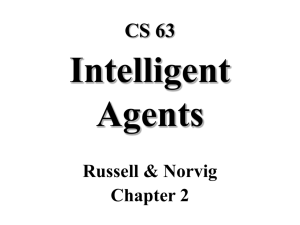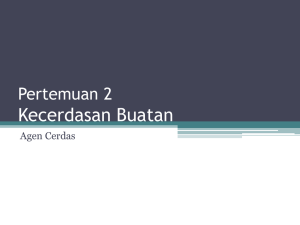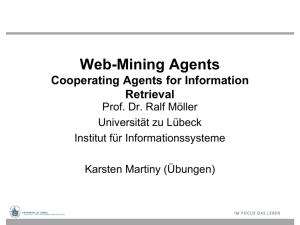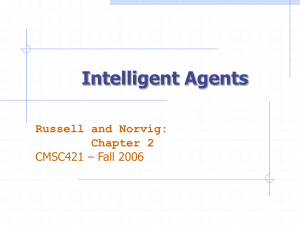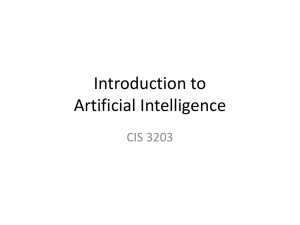Document
advertisement
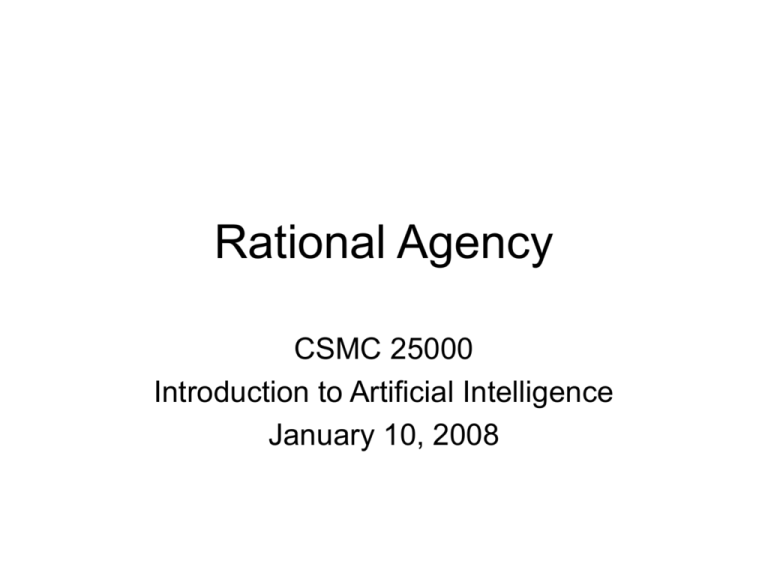
Rational Agency CSMC 25000 Introduction to Artificial Intelligence January 10, 2008 Studying AI • Develop principles for rational agents – Implement components to construct • Knowledge Representation and Reasoning – What do we know, how do we model it, how we manipulate it • Search, constraint propagation, Logic, Planning • Machine learning • Applications to perception and action – Language, speech, vision, robotics. Roadmap • Rational Agents – Defining a Situated Agent – Defining Rationality – Defining Situations • What makes an environment hard or easy? – Types of Agent Programs • Reflex Agents – Simple & Model-Based • Goal & Utility-based Agents • Learning Agents – Conclusion Situated Agents • Agents operate in and with the environment – Use sensors to perceive environment • Percepts – Use actuators to act on the environment • Agent function – Percept sequence -> Action • Conceptually, table of percepts/actions defines agent • Practically, implement as program Situated Agent Example • Vacuum cleaner: – Percepts: Location (A,B); Dirty/Clean – Actions: Move Left, Move Right; Vacuum • • • • • • A,Clean -> Move Right A,Dirty -> Vacuum B,Clean -> Move Left B,Dirty -> Vacuum A,Clean, A,Clean -> Right A,Clean, A,Dirty -> Vacuum..... What is Rationality? • “Doing the right thing” • What's right? What is success??? • Solution: – Objective, externally defined performance measure • Goals in environment • Can be difficult to design – Rational behavior depends on: • Performance measure, agent's actions, agent's percept sequence, agent's knowledge of environment Rational Agent Definition • For each possible percept sequence, – A rational agent should act so as to maximize performance, given knowledge of the environment • So is our agent rational? • Check conditions – What if performance measure differs? Limits and Requirements of Rationality • Rationality isn't perfection – Best action given what the agent knows THEN • Can't tell the future • Rationality requires information gathering – Need to incorporate NEW percepts • Rationality requires learning – Percept sequences potentially infinite • Don't hand-code – Use learning to add to built-in knowledge • Handle new experiences Defining Task Environments • Performance measure • Environment • Actuators • Sensors Classes of Environments • Observable vs. Not (fully) observable. – Does the agent see the complete state of the environment? • Deterministic vs. Nondeterministic. – Is there a unique mapping from one state to another state for a given action? • Episodic vs. Sequential – Does the next “episode” depend on the actions taken in previous episodes? • Static vs. Dynamic. – Can the world change while the agent is thinking? • Discrete vs. Continuous. – Are the distinct percepts and actions limited or unlimited? Environment Types Observable Crossword Puzzle Part-picking robot Web shopping program ForeignLanguage Tutor Medical Diagnosis Taxi driving Deterministic Episodic Static Discrete Environment Types Crossword Puzzle Part-picking robot Web shopping program ForeignLanguage Tutor Medical Diagnosis Taxi driving Observable Deterministic Episodic Static Discrete (Yes) Yes Yes No Yes Environment Types Observable Deterministic Episodic Static Discrete Crossword Puzzle (Yes) Yes No Yes Yes Part-picking robot No No Yes No No Web shopping program ForeignLanguage Tutor Medical Diagnosis Taxi driving Environment Types Observable Deterministic Episodic Static Discrete Crossword Puzzle (Yes) Yes No Yes Yes Part-picking robot No No Yes No No Web shopping program No No No No Yes ForeignLanguage Tutor Medical Diagnosis Taxi driving Environment Types Observable Deterministic Episodic Static Discrete Crossword Puzzle (Yes) Yes No Yes Yes Part-picking robot No No Yes No No Web shopping program No No No No Yes ForeignLanguage Tutor No No No Yes Yes Medical Diagnosis Taxi driving Environment Types Observable Deterministic Episodic Static Discrete Crossword Puzzle (Yes) Yes No Yes Yes Part-picking robot No No Yes No No Web shopping program No No No No Yes ForeignLanguage Tutor No No No Yes Yes Medical Diagnosis No No No No No Taxi driving Environment Types Observable Deterministic Episodic Static Discrete Crossword Puzzle (Yes) Yes No Yes Yes Part-picking robot No No Yes No No Web shopping program No No No No Yes ForeignLanguage Tutor No No No Yes Yes Medical Diagnosis No No No No No Taxi driving No No No No No Examples Vacuum cleaner Assembly line robot Language Tutor Waiter robot Agent Structure • Agent = architecture + program – Architecture: system of sensors & actuators – Program: Code to map percepts to actions • All take sensor input & produce actuator command • Most trivial: – Tabulate agent function mapping • Program is table lookup • Why not? – It works, but HUGE • Too big to store, learn, program, etc.. – Want mechanism for rational behavior – not just table Simple Reflex Agents • Single current percept • Rules relate – “State” based on percept, to – “Action” for agent to perform – “Condition-action” rule: • If a then b: e.g. if in(A) and dirty(A), then vacuum • Simple, but VERY limited – Must be fully observable to be accurate Model-based Reflex Agent • Solution to partial observability problems – Maintain state • Parts of the world can't see now – Update previous state based on • Knowledge of how world changes: e.g. Inertia • Knowledge of effects of own actions • => “Model” • Change: – New percept + Model+Old state => New state – Select rule and action based on new percept Goal-based Agents • Reflexes aren't enough! – Which way to turn? • Depends on where you want to go!! • Have goal: Desirable states – Future state (vs current situation in reflex) • Achieving goal can be complex – E.g. Finding a route – Relies on search and planning Utility-based Agents • Goal: – Issue: Only binary: achieved/not achieved – Want more nuanced: • Not just achieve state, but faster, cheaper, smoother,... • Solution: Utility – Utility function: state (sequence) -> value – Select among multiple or conflicting goals Learning Agents • Problem: – All agent knowledge pre-coded • Designer can't or doesn't want to anticipate everything • Solution: – Learning: allow agent to match new states/actions – Components: • • • • Learning element: makes improvements Performance element: picks actions based on percept Critic: gives feedback to learning about success Problem generator: suggests actions to find new states Conclusions • Agents use percepts of environment to produce actions: agent function • Rational agents act to maximize performance • Specify task environment with – Performance measure, action, environment, sensors • Agent structures from simple to complex, more powerful – Simple and model-based reflex agents – Binary goal and general utility-based agents – + Learning
